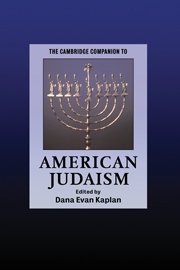Book contents
- Frontmatter
- Introduction
- Part I Historical overviews
- Part II Themes and concepts
- Section 1 Religious Culture and Institutional Practice
- Section 2 Identity and Community
- 9 The place of Judaism in American Jewish identity
- 10 The Holocaust in American Jewish life
- 11 Long-distance nationalism
- 12 Life-cycle rituals
- 13 Choosing lives
- 14 The body and sexuality in American Jewish culture
- Section 3 Living in America
- Section 4 Jewish Art in America
- Section 5 The Future
- Afterword
- Further reading
- Index
- Series list
10 - The Holocaust in American Jewish life
from Section 2 - Identity and Community
Published online by Cambridge University Press: 28 May 2006
- Frontmatter
- Introduction
- Part I Historical overviews
- Part II Themes and concepts
- Section 1 Religious Culture and Institutional Practice
- Section 2 Identity and Community
- 9 The place of Judaism in American Jewish identity
- 10 The Holocaust in American Jewish life
- 11 Long-distance nationalism
- 12 Life-cycle rituals
- 13 Choosing lives
- 14 The body and sexuality in American Jewish culture
- Section 3 Living in America
- Section 4 Jewish Art in America
- Section 5 The Future
- Afterword
- Further reading
- Index
- Series list
Summary
AMERICA AND THE HOLOCAUST
Beginning in the 1930s, as Hitler’s Germany persecuted and eventually murdered Jews, America turned a blind eye. Until the Japanese attack at Pearl Harbor, Americans were unwilling to be drawn into European power struggles or take sides between Hitler and his intended victims. Gallup polls from the 1930s show that Americans regarded “staying neutral” as their most important concern. Even after the Anschluss, Kristallnacht, and the Evian conference, the United States government refused to lift immigration restrictions for frantic Jewish refugees. In 1939, America refused to accept 20,000 German-Jewish children from the Kindertransport, and it also turned back the Hamburg-American Line’s SS St. Louis, a ship carrying 900 Jewish refugees that reached American shores after being stranded in the Caribbean when their Cuban visas were canceled. America also refused to press Britain to rescind the British White Paper of May 1939 that limited immigration to Palestine by European Jews fleeing Hitler. By 1942, the governments allied against Hitler were well informed about concentration camps and the tragic fate of the Jews, but they did little to mitigate it. Toward the end of the war, the United States and its Allies refused to bomb the gas chambers or the railroad tracks to Auschwitz and other killing centers.
- Type
- Chapter
- Information
- The Cambridge Companion to American Judaism , pp. 187 - 208Publisher: Cambridge University PressPrint publication year: 2005
- 1
- Cited by

